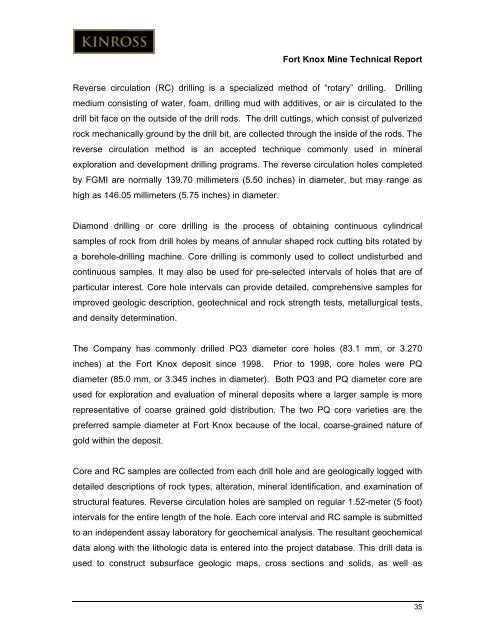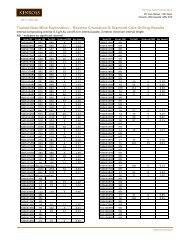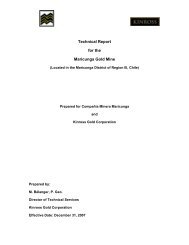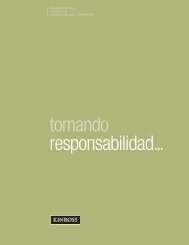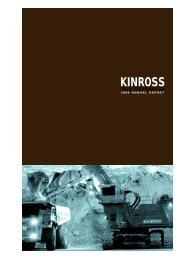Technical Report for the Fort Knox Mine - Kinross Gold
Technical Report for the Fort Knox Mine - Kinross Gold
Technical Report for the Fort Knox Mine - Kinross Gold
You also want an ePaper? Increase the reach of your titles
YUMPU automatically turns print PDFs into web optimized ePapers that Google loves.
<strong>Fort</strong> <strong>Knox</strong> <strong>Mine</strong> <strong>Technical</strong> <strong>Report</strong>Reverse circulation (RC) drilling is a specialized method of “rotary” drilling. Drillingmedium consisting of water, foam, drilling mud with additives, or air is circulated to <strong>the</strong>drill bit face on <strong>the</strong> outside of <strong>the</strong> drill rods. The drill cuttings, which consist of pulverizedrock mechanically ground by <strong>the</strong> drill bit, are collected through <strong>the</strong> inside of <strong>the</strong> rods. Thereverse circulation method is an accepted technique commonly used in mineralexploration and development drilling programs. The reverse circulation holes completedby FGMI are normally 139.70 millimeters (5.50 inches) in diameter, but may range ashigh as 146.05 millimeters (5.75 inches) in diameter.Diamond drilling or core drilling is <strong>the</strong> process of obtaining continuous cylindricalsamples of rock from drill holes by means of annular shaped rock cutting bits rotated bya borehole-drilling machine. Core drilling is commonly used to collect undisturbed andcontinuous samples. It may also be used <strong>for</strong> pre-selected intervals of holes that are ofparticular interest. Core hole intervals can provide detailed, comprehensive samples <strong>for</strong>improved geologic description, geotechnical and rock strength tests, metallurgical tests,and density determination.The Company has commonly drilled PQ3 diameter core holes (83.1 mm, or 3.270inches) at <strong>the</strong> <strong>Fort</strong> <strong>Knox</strong> deposit since 1998. Prior to 1998, core holes were PQdiameter (85.0 mm, or 3.345 inches in diameter). Both PQ3 and PQ diameter core areused <strong>for</strong> exploration and evaluation of mineral deposits where a larger sample is morerepresentative of coarse grained gold distribution. The two PQ core varieties are <strong>the</strong>preferred sample diameter at <strong>Fort</strong> <strong>Knox</strong> because of <strong>the</strong> local, coarse-grained nature ofgold within <strong>the</strong> deposit.Core and RC samples are collected from each drill hole and are geologically logged withdetailed descriptions of rock types, alteration, mineral identification, and examination ofstructural features. Reverse circulation holes are sampled on regular 1.52-meter (5 foot)intervals <strong>for</strong> <strong>the</strong> entire length of <strong>the</strong> hole. Each core interval and RC sample is submittedto an independent assay laboratory <strong>for</strong> geochemical analysis. The resultant geochemicaldata along with <strong>the</strong> lithologic data is entered into <strong>the</strong> project database. This drill data isused to construct subsurface geologic maps, cross sections and solids, as well as35


